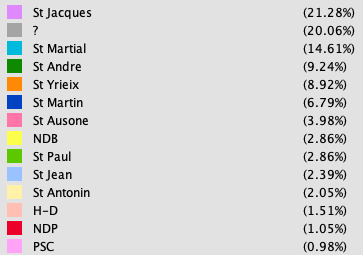ANGOULÊME iN 1764
This graph depicts the social relations of the 4,089 individuals who appear in the parish records for the central parishes of Angoulême in 1764.

The graph maps three basic kinds of relationships: family, being a godparent, and presence at a life-event (baptism, marriage, and death). Family connections are weighted the most heavily and therefore pull the connected nodes together most strongly. Godparent-godchild relationships and sibling relationships are weighted next most heavily, and signatory (or witness) relationships the least heavily. The weights can be seen on the downloadable .pdf or in the datasets. For more information, consult our "conventions".
Individuals are colored according to the parish in which they probably lived at the time. Those people whose home parish is indeterminate or who are from outside Angoulême are depicted in gray. The central parishes of the town were Notre Dame de Beaulieu, Notre Dame de la Peyne, Hotel-Dieu, St. André, St. Antonin, Petit St. Cybard, St. Jean, St. Paul, and St. Martial. The non-central parishes were St. Ausone, St. Martin, St. Yrieix, and St. Jacques de l'Houmeau. The revolutionary-era parish of St. Pierre existed only in 1792-1793. In addition to highlighting trends, this map can be used as a reference. Type in any name in the search box to find it directly on the map. A fully annotated .pdf is also available for download below the graph. On this, you will be able to tell the kinds of connections between individuals. Thick links denote family members (parents, children, siblings, and spouses), medium-thick links denote godparents, and thin links denote signatories or witnesses.
Nodes are sized proportionally to their connectedness – that is, how many connections they have. The largest node (with 22 connections) has been calibrated to be three times the size of the smallest (with 0 connections). The average node was connected to 2.6 other nodes.
